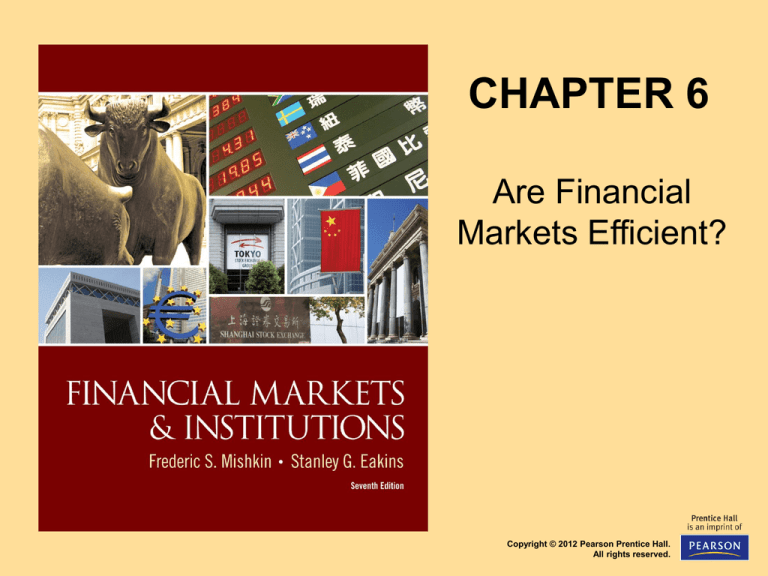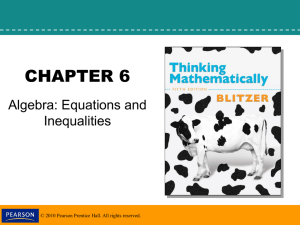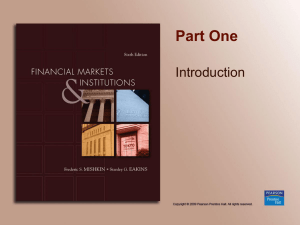
CHAPTER 6
Are Financial
Markets Efficient?
Copyright © 2012 Pearson Prentice Hall.
All rights reserved.
Chapter Preview
Expectations are very important in our
financial system.
─ Expectations of returns, risk, and liquidity
impact asset demand
─ Inflationary expectations impact bond prices
─ Expectations not only affect our understanding
of markets, but also how financial institutions
operate.
© 2012 Pearson Prentice Hall. All rights reserved.
6-1
Chapter Preview
To better understand expectations, we
examine the efficient markets hypothesis.
─ Framework for understanding what information
is useful and what is not
─ However, we need to validate the hypothesis
with real market data. The results are mixed,
but generally supportive of the idea.
© 2012 Pearson Prentice Hall. All rights reserved.
6-2
Chapter Preview
In sum, we will look at the basic reasoning
behind the efficient market hypothesis. We
also examine empirical evidence examining
this idea. Topics include:
─ The Efficient Market Hypothesis
─ Evidence on the Efficient Market Hypothesis
─ Behavioral Finance
© 2012 Pearson Prentice Hall. All rights reserved.
6-3
Efficient Market Hypothesis
Recall from Chapter 3 that the rate of return for any
position is the sum of the capital gains (Pt+1 – Pt) plus
any cash payments (C):
At the start of a period, the unknown element is the future
price: Pt+1. But, investors do have some expectation of
that price, thus giving us an expected rate of return.
© 2012 Pearson Prentice Hall. All rights reserved.
6-4
Efficient Market Hypothesis
The Efficient Market Hypothesis views the expectations as
equal to optimal forecasts using all available information.
This implies:
Assuming the market is in equilibrium:
Re = R*
Put these ideas together: efficient market hypothesis
Rof = R*
© 2012 Pearson Prentice Hall. All rights reserved.
6-5
Efficient Market Hypothesis
Rof = R*
This equation tells us that current prices in a financial
market will be set so that the optimal forecast of a
security’s return using all available information equals
the security’s equilibrium return.
As a result, a security’s price fully reflects all available
information in an efficient market.
Note, R* depends on risk, liquidity, other asset returns
…
© 2012 Pearson Prentice Hall. All rights reserved.
6-6
Rationale Behind
the Hypothesis (cont.)
Why efficient market hypothesis makes sense
If Rof > R* → Pt ↑ → Rof ↓
If Rof < R* → Pt ↓ → Rof ↑
Until Rof = R*
All unexploited profit opportunities eliminated
Efficient market condition holds even if there are
uninformed, irrational participants in market
© 2012 Pearson Prentice Hall. All rights reserved.
6-7
Rationale Behind the
Hypothesis
When an unexploited profit opportunity
arises on a security (so-called because, on
average, people would be earning more
than they should, given the characteristics
of that security), investors will rush to buy
until the price rises to the point that the
returns are normal again.
Investors do not leave $5 bills lying on the
sidewalk.
© 2012 Pearson Prentice Hall. All rights reserved.
6-8
Rationale Behind
the Hypothesis (cont.)
In an efficient market, all unexploited profit
opportunities will be eliminated.
Not every investor need be aware of every
security and situation.
Only a few investors (even 1 big one) are
needed to eliminate unexploited profit
opportunities and push the market price to
its equilibrium level.
© 2012 Pearson Prentice Hall. All rights reserved.
6-9
Evidence on Efficient
Market Hypothesis
Favorable Evidence
1. Investment analysts and mutual funds don't beat
the market
2. Stock prices reflect publicly available info:
anticipated announcements don't affect stock price
3. Stock prices and exchange rates close to random
walk; if predictions of DP big, Rof > R* predictions
of DP small
4. Technical analysis does not outperform market
© 2012 Pearson Prentice Hall. All rights reserved.
6-10
Evidence in Favor
of Market Efficiency
Performance of Investment Analysts and
Mutual Funds should not be able to
consistently beat the market
─ The “Investment Dartboard” often beats investment
managers.
─ Mutual funds not only do not outperform the market on
average, but when they are separated into groups
according to whether they had the highest or lowest
profits in a chosen period, the mutual funds that did
well in the first period do not beat the market in the
second period.
© 2012 Pearson Prentice Hall. All rights reserved.
6-11
Evidence in Favor
of Market Efficiency
Performance of Investment Analysts and
Mutual Funds should not be able to
consistently beat the market
─ Investment strategies using inside information
is the only “proven method” to beat the market.
In the U.S., it is illegal to trade on such
information, but that is not true in all countries.
© 2012 Pearson Prentice Hall. All rights reserved.
6-12
Evidence in Favor
of Market Efficiency
Do Stock Prices Reflect Publicly
Available Information as the EMH
predicts they will?
─ Thus if information is already publicly
available, a positive announcement about a
company will not, on average, raise the price
of its stock because this information is already
reflected in the stock price.
© 2012 Pearson Prentice Hall. All rights reserved.
6-13
Evidence in Favor
of Market Efficiency
Do Stock Prices Reflect Publicly
Available Information as the EMH
predicts they will?
─ Early empirical evidence confirms: favorable
earnings announcements or announcements
of stock splits (a division of a share of stock
into multiple shares, which is usually followed
by higher earnings) do not, on average, cause
stock prices to rise.
© 2012 Pearson Prentice Hall. All rights reserved.
6-14
Evidence in Favor
of Market Efficiency
Random-Walk Behavior of Stock Prices that
is, future changes in stock prices should, for
all practical purposes, be unpredictable
─ If stock is predicted to rise, people will buy to
equilibrium level; if stock is predicted to fall, people will
sell to equilibrium level (both in concert with EMH)
─ Thus, if stock prices were predictable, thereby causing
the above behavior, price changes would be near
zero, which has not been the case historically
© 2012 Pearson Prentice Hall. All rights reserved.
6-15
Evidence in Favor
of Market Efficiency
Technical Analysis means to study past stock price
data and search for patterns such as trends and
regular cycles, suggesting rules for when to buy and
sell stocks
─
─
─
The EMH suggests that technical analysis is a waste
of time
The simplest way to understand why is to use the random-walk
result that holds that past stock price data cannot help predict
changes
Therefore, technical analysis, which relies on such data to
produce its forecasts, cannot successfully predict changes in
stock prices
© 2012 Pearson Prentice Hall. All rights reserved.
6-16
Case: Foreign Exchange Rates
Could you make a bundle if you could
predict FX rates? Of course.
EMH predicts, then, that FX rates should be
unpredictable.
That is exactly what empirical tests show—
FX rates are not very predictable.
© 2012 Pearson Prentice Hall. All rights reserved.
6-17
Evidence on Efficient
Market Hypothesis
Unfavorable Evidence
1.
2.
3.
4.
5.
6.
Small-firm effect: small firms have abnormally high returns
January effect: high returns in January
Market overreaction
Excessive volatility
Mean reversion
New information is not always immediately incorporated into
stock prices
Overview
─
Reasonable starting point but not whole story
© 2012 Pearson Prentice Hall. All rights reserved.
6-18
Evidence Against Market
Efficiency
The Small-Firm Effect is an anomaly. Many empirical
studies have shown that small firms have earned
abnormally high returns over long periods of time,
even when the greater risk for these firms has been
considered.
─
─
The small-firm effect seems to have diminished in recent years
but is still a challenge to the theory of efficient markets
Various theories have been developed to explain the small-firm
effect, suggesting that it may be due to rebalancing of portfolios
by institutional investors, tax issues, low liquidity of small-firm
stocks, large information costs in evaluating small firms, or an
inappropriate measurement of risk for small-firm stocks
© 2012 Pearson Prentice Hall. All rights reserved.
6-19
Evidence Against Market
Efficiency
The January Effect is the tendency of
stock prices to experience an abnormal
positive return in the month of January
that is predictable and, hence,
inconsistent with random-walk behavior
© 2012 Pearson Prentice Hall. All rights reserved.
6-20
Evidence Against Market
Efficiency
Investors have an incentive to sell stocks before the end
of the year in December because they can then take
capital losses on their tax return and reduce their tax
liability. Then when the new year starts in January, they
can repurchase the stocks, driving up their prices and
producing abnormally high returns.
Although this explanation seems sensible, it does not
explain why institutional investors such as private pension
funds, which are not subject to income taxes, do not take
advantage of the abnormal returns in January and buy
stocks in December, thus bidding up their price and
eliminating the abnormal returns.
© 2012 Pearson Prentice Hall. All rights reserved.
6-21
Evidence Against Market
Efficiency
Market Overreaction: recent research suggests that
stock prices may overreact to news announcements
and that the pricing errors are corrected only slowly
─
─
When corporations announce a major change in earnings, say, a
large decline, the stock price may overshoot, and after an initial
large decline, it may rise back to more normal levels over a period
of several weeks.
This violates the EMH because an investor could earn abnormally
high returns, on average, by buying a stock immediately after a
poor earnings announcement and then selling it after a couple of
weeks when it has risen back to normal levels.
© 2012 Pearson Prentice Hall. All rights reserved.
6-22
Evidence Against Market
Efficiency
Excessive Volatility: the stock market appears to display
excessive volatility; that is, fluctuations in stock prices may
be much greater than is warranted by fluctuations in their
fundamental value.
─
─
Researchers have found that fluctuations in the S&P 500 stock
index could not be justified by the subsequent fluctuations in the
dividends of the stocks making up this index.
Other research finds that there are smaller fluctuations in stock
prices when stock markets are closed, which has produced a
consensus that stock market prices appear to be driven by factors
other than fundamentals.
© 2012 Pearson Prentice Hall. All rights reserved.
6-23
Evidence Against Market
Efficiency
Mean Reversion: Some researchers have found that
stocks with low returns today tend to have high returns in
the future, and vice versa.
─
─
Hence stocks that have done poorly in the past are more likely to
do well in the future because mean reversion indicates that there
will be a predictable positive change in the future price,
suggesting that stock prices are not a random walk.
Newer data is less conclusive; nevertheless, mean reversion
remains controversial.
© 2012 Pearson Prentice Hall. All rights reserved.
6-24
Evidence Against Market
Efficiency
New Information Is Not Always Immediately
Incorporated into Stock Prices
─
─
Although generally true, recent evidence suggests that,
inconsistent with the efficient market hypothesis, stock prices do
not instantaneously adjust to profit announcements.
Instead, on average stock prices continue to rise for some time
after the announcement of unexpectedly high profits, and they
continue to fall after surprisingly low profit announcements.
© 2012 Pearson Prentice Hall. All rights reserved.
6-25
THE PRACTICING MANAGER:
Implications for Investing
1. How valuable are published reports by
investment advisors?
2. Should you be skeptical of hot tips?
3. Do stock prices always rise when there is
good news?
4. Efficient Markets prescription for investor
© 2012 Pearson Prentice Hall. All rights reserved.
6-26
Implications for Investing
How valuable are published reports by
investment advisors?
© 2012 Pearson Prentice Hall. All rights reserved.
6-27
Implications for Investing
1. Should you be skeptical of hot tips?
─ YES. The EMH indicates that you should be
skeptical of hot tips since, if the stock market
is efficient, it has already priced the hot tip
stock so that its expected return will equal the
equilibrium return.
─ Thus, the hot tip is not particularly valuable
and will not enable you to earn an abnormally
high return.
© 2012 Pearson Prentice Hall. All rights reserved.
6-28
Implications for Investing
2. Should you be skeptical of hot tips?
─ As soon as the information hits the street, the
unexploited profit opportunity it creates will be
quickly eliminated.
─ The stock’s price will already reflect the
information, and you should expect to realize
only the equilibrium return.
© 2012 Pearson Prentice Hall. All rights reserved.
6-29
Implications for Investing
3. Do stock prices always rise when there is
good news?
─ NO. In an efficient market, stock prices will respond to
announcements only when the information being
announced is new and unexpected.
─ So, if good news was expected (or as good as
expected), there will be no stock price response.
─ And, if good news was unexpected (or not as good as
expected), there will be a stock price response.
© 2012 Pearson Prentice Hall. All rights reserved.
6-30
Implications for Investing
Efficient Markets prescription for investor
─ Investors should not try to outguess the
market by constantly buying and selling
securities. This process does nothing but incur
commissions costs on each trade.
© 2012 Pearson Prentice Hall. All rights reserved.
6-31
Implications for Investing
Efficient Markets prescription for investor
─ Instead, the investor should pursue a “buy and
hold” strategy—purchase stocks and hold
them for long periods of time. This will lead to
the same returns, on average, but the
investor’s net profits will be higher because
fewer brokerage commissions will have to be
paid.
© 2012 Pearson Prentice Hall. All rights reserved.
6-32
Implications for Investing
Efficient Markets prescription for investor
─ It is frequently a sensible strategy for a small investor,
whose costs of managing a portfolio may be high
relative to its size, to buy into a mutual fund rather
than individual stocks. Because the EMH indicates
that no mutual fund can consistently outperform the
market, an investor should not buy into one that has
high management fees or that pays sales
commissions to brokers but rather should purchase a
no-load (commission-free) mutual fund that has low
management fees.
Management Costs
© 2012 Pearson Prentice Hall. All rights reserved.
6-33
All mutual funds sold to the public – performance of all
general equity mutual funds compared to the Wilshire
5000 Index. In most years more than ½ of the funds
were outperformed by the index. Over the 26.5 year
period about 2/3 of the funds proved inferior to the
market as a whole. Same result holds for professional
pension managers.
Implications for Investing
Cost Compare
©Prentice
2006 Pearson
Addison-Wesley.
© Copyright
2012 Pearson
Hall. All rights
reserved.
All rights reserved.
6-34
6-34
Case: Any Efficient Markets Lessons from Black
Monday of 1987 and the Tech Crash of 2000?
Does any version of Efficient Markets Hypothesis (EMH)
hold in light of sudden or dramatic
market declines?
Strong version EMH?
Weaker version EMH?
A bubble is a situation in which the price of an asset
differs from its fundamental market value?
Can bubbles be rational?
Role of behavioral finance
© 2012 Pearson Prentice Hall. All rights reserved.
6-35
Behavioral Finance
BF argues that a few psychological phenomena
pervade financial markets:
1. Practitioners rely on rules of thumb called heuristics to
process information.
─ Heuristic—a process by which people find things out
for themselves, usually by trial and error. Leads to the
development of rules of thumb which are imperfect
and result in errors which lead to heuristic-driven
bias.
© 2012 Pearson Prentice Hall. All rights reserved.
6-36
Behavioral Finance
BF argues that a few psychological phenomena
pervade financial markets:
2. In addition to objective considerations, practitioners
perception of risk & return are highly influenced by
how decision problems are framed frame
dependence.
3. Heuristic-driven bias and framing effects cause market
prices to deviate from fundamental values, i.e.
markets are inefficient.
© 2012 Pearson Prentice Hall. All rights reserved.
6-37
Heuristic Driven Bias
Representativeness—reliance on stereotypes
─ Example of High School GPA as predictor of College
GPA and reversion to the mean.
Overconfidence
─ People set overly narrow confidence bands, high
guess is too low and low guess is too high.
─ Results in being surprised too often.
Anchoring to old information
─ Security analysts do not revise their earnings
estimates enough to reflect new info.
© 2012 Pearson Prentice Hall. All rights reserved.
6-38
Frame Dependence
EMH assumes framing is transparent—If you
move a $ from your right pocket to your left
pocket, you are no wealthier! (Merton Miller)
… In other words, practitioners can see through
all the different ways that cash flow might be
described.
But if frame is opaque, a difference in form
(which pocket) is also a difference in substance
and affects behavior.
© 2012 Pearson Prentice Hall. All rights reserved.
6-39
Frame Dependence
Loss Aversion
─ Choose between
•
•
Sure loss of $7,500 or
75% chance of loosing $10K or 25% chance of loosing $0.
Hedonic editing
─ Organizing Gains and Losses in separate mental
accounts.
•
•
•
One loss and one gain are netted against each other.
Two gains are savored separately
But multiple losses are difficult to net out against moderate
gains.
© 2012 Pearson Prentice Hall. All rights reserved.
6-40
Frame Dependence
Hedonic editing
1. Imagine that you face the following choice. You can
accept a guaranteed $1500 or play a lottery. The
outcome of the lottery is determined by the toss of a
fair coin.
Heads—> you win $1950
Tails—> you win $1050
Which would you chose?
Are you risk averse?
© 2012 Pearson Prentice Hall. All rights reserved.
6-41
Frame Dependence
Hedonic editing
2. Imagine that you face the following choice. You can
accept a guaranteed loss of $750 or play a lottery.
The outcome of the lottery is determined by the toss
of a fair coin.
Heads—> you loose $750
Tails—> you loose $525
Which would you chose?
© 2012 Pearson Prentice Hall. All rights reserved.
6-42
Frame Dependence
Hedonic editing
3. Now imagine that you have just won $1500 in one
lottery, and you can choose to participate in another.
The outcome of this second lottery is determined by
the toss of a fair coin.
Heads—> you win $450
Tails—> you win $450
Would you choose to participate in the second lottery?
© 2012 Pearson Prentice Hall. All rights reserved.
6-43
Frame Dependence
Hedonic editing has both cognitive and
emotional causes
─ Main cognitive issue in choice 3 above—Do you
ignore the preliminary $1500 winnings or not?
─ Those that begin by seeing themselves $1500 ahead
then experience the emotion of loosing $450 as the
equivalent of winning $1050 (i.e. a smaller gain, not a
loss).
─ Those that ignore the $1500 are less prone to accept
the gamble because they will feel a $450 loss as a
loss.
© 2012 Pearson Prentice Hall. All rights reserved.
6-44
Chapter Summary
The Efficient Market Hypothesis: We
examined the theory of how both old and
new information are expected to be
incorporated into current stock prices.
Evidence on the Efficient Market
Hypothesis: We looked at evidence for
various tests of the hypothesis and how
well the hypothesis holds.
© 2012 Pearson Prentice Hall. All rights reserved.
6-45
Chapter Summary
Behavioral Finance: We also examined
another important area of research to
explain how stock prices are formed based
on psychological factors affecting investors.
© 2012 Pearson Prentice Hall. All rights reserved.
6-46






